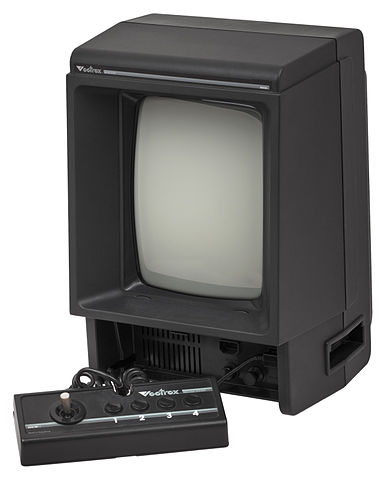






















The Vectrex Arcade System
Find the best deals on Vectrex games at Player's Choice.
Released in 1982 by GCE (later distributed by Milton Bradley), the Vectrex was a one-of-a-kind home gaming console that stood out from its contemporaries. Unlike traditional consoles that connected to a television, the Vectrex featured a built-in monochrome CRT screen, displaying crisp vector-based graphics similar to arcade games like Asteroids and Tempest.
The system came with an integrated analog joystick and buttons, neatly stored in a compartment below the screen. To add color and enhance visuals, each game used plastic screen overlays, which created an illusion of different colors and backgrounds. While limited in resolution, the sharp, bright vector graphics made for a distinctive arcade-like experience that no other home console at the time could replicate.
The Vectrex launched with built-in software, Mine Storm, a fast-paced space shooter, and supported a small but memorable library of arcade-inspired titles such as Scramble, Star Castle, and Spike. An optional 3D Imager attachment even introduced early stereoscopic 3D effects, making the Vectrex one of the most innovative systems of its era.
Unfortunately, due to the video game crash of 1983, the Vectrex was discontinued by 1984, despite its impressive technology. Today, it is a highly sought-after collector's item, cherished for its unique display, arcade-perfect vector graphics, and innovative design.
When the Vectrex launched in 1982, it was unlike anything else on the home gaming market. Instead of relying on a standard television, this innovative console featured a built-in monochrome CRT screen, delivering stunning vector-based graphics that closely resembled arcade classics like Asteroids and Tempest. While its uniqueness made it stand out, the system was ultimately short-lived, largely due to the video game crash of 1983. However, today it remains a beloved collector's item, praised for its ahead-of-its-time technology and distinct visual style.
The Vectrex's all-in-one design was a major selling point. The compact system housed a 9-inch CRT display, eliminating the need for a separate TV. Its vector graphics produced sharp, bright, and fluid animations, a stark contrast to the blocky pixel-based visuals of competitors like the Atari 2600 and Intellivision.
The console's built-in controller featured an analog joystick and four action buttons, offering precise control over fast-paced arcade-style games. The controller tucked neatly into a compartment at the base of the unit, making storage convenient. However, controller durability was an issue, as its design was prone to wear over time.
To compensate for the lack of color, games came with plastic screen overlays that added visual flair. While this was a clever workaround, the overlays could sometimes be misaligned or easily damaged, making them an imperfect solution.
The Vectrex launched with Mine Storm, a built-in Asteroids-style shooter that was widely praised and remains one of the best games on the system. The overall game library was small (around 28 officially released titles), but it included several excellent arcade-style games, such as:
One of the Vectrex's most ambitious innovations was the 3D Imager, an accessory that introduced stereoscopic 3D effects-a feature far ahead of its time. While only a few games supported it, this was an impressive technological feat for the early 1980s.
While the Vectrex had groundbreaking technology, it wasn't without flaws:
The Vectrex was a visionary console that brought true arcade-style vector graphics into the home. While it suffered from a small library and a short lifespan, its innovative hardware, unique display, and smooth gameplay made it a standout system in gaming history. Today, it's a highly sought-after collector's item, cherished for its one-of-a-kind gaming experience.
? A remarkable and innovative system that was ahead of its time, but limited by a small library and an early demise. Perfect for retro enthusiasts and collectors.
Would you like comparisons with other early consoles, or details on modern homebrew development for the Vectrex?